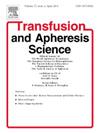利用可见光评估核黄素浓度和光强度对血小板中细菌减少的影响。
IF 1.4
4区 医学
Q4 HEMATOLOGY
引用次数: 0
摘要
多年来,血小板中的细菌污染问题一直备受关注。在这项研究中,我们发现用不同浓度核黄素的 420 纳米可见光处理血小板后,大肠杆菌和金黄色葡萄球菌分别减少了 0-1.56 和 0.3-2.02 个对数值(50 mW/cm2)、2.24-4.77 和 0.73-3.26 个对数值(75 mW/cm2)以及≥ 5.14 和≥ 5.27 个对数值(100 mW/cm2)。使用高强度光(100 mW/cm2)和高浓度核黄素(400 µM 和 500 µM)可有效减少血小板中的两种细菌,减少幅度超过 4 个对数值。研究还发现,细菌减少量与光照强度以及核黄素浓度呈正相关,且呈剂量依赖性。这些结果证明了利用核黄素和可见光降低血小板中细菌污染风险的潜力,并支持进一步探索利用 420 纳米可见光和核黄素减少病原体的必要性。本文章由计算机程序翻译,如有差异,请以英文原文为准。
Evaluation of riboflavin concentrations and light intensities on bacteria reduction in platelets using visible light
Bacterial contamination in platelets has been a major concern over the years. In this study, we showed that treatment with 420 nm visible light with various concentrations of riboflavin in platelets reduced E. coli and S. aureus by 0–1.56 and 0.3–2.02 logs (50 mW/cm2), 2.24–4.77 and 0.73–3.26 logs (75 mW/cm2), and ≥ 5.14 and ≥ 5.27 logs (100 mW/cm2). Treatment with high-intensity light (100 mW/cm2) and high concentrations of riboflavin (400 µM and 500 µM) effectively reduced both bacteria in platelets by over 4 logs. The study also found a positive correlation between bacterial reduction and light intensity, as well as riboflavin concentration in a dose-dependent manner. These results demonstrate the potential of using riboflavin and visible light to reduce the risk of bacterial contamination in platelets, and support the need for further exploration of pathogen reduction using 420 nm visible light and riboflavin.
求助全文
通过发布文献求助,成功后即可免费获取论文全文。
去求助
来源期刊
CiteScore
3.60
自引率
5.30%
发文量
181
审稿时长
42 days
期刊介绍:
Transfusion and Apheresis Science brings comprehensive and up-to-date information to physicians and health care professionals involved in the rapidly changing fields of transfusion medicine, hemostasis and apheresis. The journal presents original articles relating to scientific and clinical studies in the areas of immunohematology, transfusion practice, bleeding and thrombotic disorders and both therapeutic and donor apheresis including hematopoietic stem cells. Topics covered include the collection and processing of blood, compatibility testing and guidelines for the use of blood products, as well as screening for and transmission of blood-borne diseases. All areas of apheresis - therapeutic and collection - are also addressed. We would like to specifically encourage allied health professionals in this area to submit manuscripts that relate to improved patient and donor care, technical aspects and educational issues.
Transfusion and Apheresis Science features a "Theme" section which includes, in each issue, a group of papers designed to review a specific topic of current importance in transfusion and hemostasis for the discussion of topical issues specific to apheresis and focuses on the operators'' viewpoint. Another section is "What''s Happening" which provides informal reporting of activities in the field. In addition, brief case reports and Letters to the Editor, as well as reviews of meetings and events of general interest, and a listing of recent patents make the journal a complete source of information for practitioners of transfusion, hemostasis and apheresis science. Immediate dissemination of important information is ensured by the commitment of Transfusion and Apheresis Science to rapid publication of both symposia and submitted papers.

 求助内容:
求助内容: 应助结果提醒方式:
应助结果提醒方式:


